Gain-Scheduled Model Predictive Control for Cart–Inverted-Pendulum with Friction and Disturbances
Abstract
:1. Introduction
- (1)
- The dynamic equation of the CIPS with friction and disturbances is established based on the Newton–Euler equation.
- (2)
- The gain-scheduled model predictive control method is proposed to stabilize the SIP of the CIPS in the upright position while the cart moves to its desired position.
- (3)
- The proposed gain-scheduled model predictive control method is verified by several simulations.
2. Dynamic Equation and Characteristics Analysis
2.1. Dynamical Equation
2.2. Analyses of Motion Characteristics and Control Process
- (1)
- When the desired position is changed as a step setpoint, the cart can be controlled to reach this position, where is the maximum controllable motion range of the cart.
- (2)
- During the process of controlling the cart to track the desired position, , the SIP oscillates. When the cart reaches the desired position, , the pendulum angle of the SIP converges to zero, i.e., the SIP returns to the upright equilibrium point.
- (3)
- When considering the friction exerted to the cart, an impulse disturbance, , applied to the SIP, and an impulse disturbance applied to the cart, the above two control objectives can still be realized.
3. Controller Design
3.1. Linearization of Dynamic Equation
3.2. Design of Gain-Scheduled MPC
3.3. Stability Proof
4. Simulations
4.1. Simulations I
- Case (I–A): The CIPS is a nominal system, i.e., and in the simulation.
- Case (I–B): The SIP of the CIPS is subjected to a pulse disturbance with a magnitude of 2. As shown in Figure 7, for the ease of applying the pulse disturbance , the start time of is (s), the peak time of is (s), and the end time of is (s).
- Case (I–C): The cart of the CIPS is subjected to an impulse disturbance with a magnitude of 3. As shown in Figure 8, for the ease of applying the pulse disturbance , the start time of is (s), the peak time of is (s), and the end time of is (s).
4.2. Simulations II
- Case (II–A): The CIPS is a nominal system, i.e., and in the simulation.
- Case (II–B): The SIP of the CIPS is subjected to the disturbance, , in the form of Gaussian white noise. is shown in Figure 12.
- Case (II–C): The cart of the CIPS is subjected to the disturbance, , in the form of Gaussian white noise. is shown in Figure 13.
5. Conclusions
Author Contributions
Funding
Institutional Review Board Statement
Informed Consent Statement
Data Availability Statement
Conflicts of Interest
References
- Liu, Y.Y.; Slotine, J.J.; Barabási, A.L. Controllability of complex networks. Nature 2011, 473, 167–173. [Google Scholar] [CrossRef]
- Sankaranarayanan, V.; Mahindrakar, A.D. Control of a class of underactuated mechanical systems using sliding modes. IEEE Trans. Robot. 2009, 25, 459–467. [Google Scholar] [CrossRef]
- Odhner, L.U.; Jentoft, L.P.; Claffee, M.R.; Corson, N.; Tenzer, Y.; Ma, R.R.; Buehler, M.; Kohout, R.; Howe, R.D.; Dollar, A.M. A compliant, underactuated hand for robust manipulation. Int. J. Robot. Res. 2014, 33, 736–752. [Google Scholar] [CrossRef]
- Wang, L.; Lai, X.; Meng, Q.; Wu, M. Effective control method based on trajectory optimization for three-link vertical underactuated manipulators with only one active joint. IEEE Trans. Cybern. 2021, 53, 3782–3793. [Google Scholar] [CrossRef] [PubMed]
- Yang, T.; Chen, H.; Sun, N.; Fang, Y. Adaptive neural network output feedback control of uncertain underactuated systems with actuated and unactuated state constraints. IEEE Trans. Syst. Man Cybern. Syst. 2021, 52, 7027–7043. [Google Scholar] [CrossRef]
- Knoll, C.; Röbenack, K. Control of an underactuated manipulator using similarities to the double integrator. IFAC Proc. Vol. 2011, 44, 11501–11507. [Google Scholar] [CrossRef]
- Labrecque, P.D.; Laliberté, T.; Foucault, S.; Abdallah, M.E.; Gosselin, C. uMan: A low-impedance manipulator for human–robot cooperation based on underactuated redundancy. IEEE/ASME Trans. Mechatron. 2017, 22, 1401–1411. [Google Scholar] [CrossRef]
- Wang, L.; Lai, X.; Zhang, P.; Wu, M. A control strategy based on trajectory planning and optimization for two-link underactuated manipulators in vertical plane. IEEE Trans. Syst. Man Cybern. Syst. 2021, 52, 3466–3475. [Google Scholar] [CrossRef]
- Rigatos, G.; Siano, P.; Abbaszadeh, M. Nonlinear H-infinity control for 4-DOF underactuated overhead cranes. Trans. Inst. Meas. Control 2018, 40, 2364–2377. [Google Scholar] [CrossRef]
- Lee, H.W.; Roh, M.I.; Ham, S.H. Underactuated crane control for the automation of block erection in shipbuilding. Autom. Constr. 2021, 124, 103573. [Google Scholar] [CrossRef]
- Fu, Y.; Sun, N.; Yang, T.; Qiu, Z.; Fang, Y. Adaptive coupling anti-swing tracking control of underactuated dual boom crane systems. IEEE Trans. Syst. Man Cybern. Syst. 2021, 52, 4697–4709. [Google Scholar] [CrossRef]
- Pounds, P.E.; Dollar, A.M. Stability of helicopters in compliant contact under PD-PID control. IEEE Trans. Robot. 2014, 30, 1472–1486. [Google Scholar] [CrossRef]
- Karimoddini, A.; Lin, H.; Chen, B.M.; Lee, T.H. Hybrid three-dimensional formation control for unmanned helicopters. Automatica 2013, 49, 424–433. [Google Scholar] [CrossRef]
- Zhao, D.; Mishra, S.; Gandhi, F. A differential-flatness-based approach for autonomous helicopter shipboard landing. IEEE/ASME Trans. Mechatron. 2021, 27, 1557–1569. [Google Scholar]
- Greer, W.B.; Sultan, C. Infinite horizon model predictive control tracking application to helicopters. Aerosp. Sci. Technol. 2020, 98, 105675. [Google Scholar] [CrossRef]
- Marantos, P.; Bechlioulis, C.P.; Kyriakopoulos, K.J. Robust trajectory tracking control for small-scale unmanned helicopters with model uncertainties. IEEE Trans. Control Syst. Technol. 2017, 25, 2010–2021. [Google Scholar] [CrossRef]
- Shao, X.; Sun, G.; Yao, W.; Liu, J.; Wu, L. Adaptive sliding mode control for quadrotor UAVs with input saturation. IEEE/ASME Trans. Mechatron. 2022, 27, 1498–1509. [Google Scholar] [CrossRef]
- Ringbom, H.M.; Veal, R. Unmanned ships and the international regulatory framework. J. Int. Marit. Law 2017, 23, 100–118. [Google Scholar]
- Qu, Y.; Cai, L. Nonlinear positioning control for underactuated unmanned surface vehicles in the presence of environmental disturbances. IEEE/ASME Trans. Mechatron. 2022, 27, 5381–5391. [Google Scholar] [CrossRef]
- Chen, Y.; Chen, Y.; Chen, Y.; Zhao, H.; Mao, J.; Mao, J.; Chirarattananon, P.; Helbling, E.F.; Helbling, E.F.; Seung Patrick Hyun, N.; et al. Controlled flight of a microrobot powered by soft artificial muscles. Nature 2019, 575, 324–329. [Google Scholar] [CrossRef]
- Li, G.; Chen, X.; Zhou, F.; Liang, Y.; Xiao, Y.; Cao, X.; Zhang, Z.; Zhang, M.; Wu, B.; Yin, S.; et al. Self-powered soft robot in the Mariana Trench. Nature 2021, 591, 66–71. [Google Scholar] [CrossRef] [PubMed]
- Huang, X.; Zhu, X.; Gu, G. Kinematic modeling and characterization of soft parallel robots. IEEE Trans. Robot. 2022, 38, 3792–3806. [Google Scholar] [CrossRef]
- Ibanez, C.A.; Frias, O.G.; Castanon, M.S. Lyapunov-based controller for the inverted pendulum cart system. Nonlinear Dyn. 2005, 40, 367–374. [Google Scholar] [CrossRef]
- Maghzaoui, C.; Mansour, A.; Jerbi, H. A time-varying system control using implicit flatness: Case of an inverted pendulum. In Proceedings of the 2010 International Conference on Intelligent Systems, Modelling and Simulation, Liverpool, UK, 27–29 January 2010; pp. 276–281. [Google Scholar]
- Mondal, R.; Dey, J. Performance Analysis and Implementation of Fractional Order 2-DOF Control on Cart–Inverted Pendulum System. IEEE Trans. Ind. Appl. 2020, 56, 7055–7066. [Google Scholar] [CrossRef]
- Huang, Z.; Wei, S.; Hou, M.; Wang, L. Finite-time control strategy for swarm planar underactuated robots via motion planning and intelligent algorithm. Meas. Control 2023, 56, 813–819. [Google Scholar] [CrossRef]
- Sun, N.; Fang, Y. Nonlinear tracking control of underactuated cranes with load transferring and lowering: Theory and experimentation. Automatica 2014, 50, 2350–2357. [Google Scholar] [CrossRef]
- Muskinja, N.; Tovornik, B. Swinging up and stabilization of a real inverted pendulum. IEEE Trans. Ind. Electron. 2006, 53, 631–639. [Google Scholar] [CrossRef]
- Zhang, P.; Lai, X.; Wang, Y.; Su, C.Y.; Wu, M. A quick position control strategy based on optimization algorithm for a class of first-order nonholonomic system. Inf. Sci. 2018, 460, 264–278. [Google Scholar] [CrossRef]
- Taylor, J.R.; Taylor, J.R. Classical Mechanics; Springer: Berlin/Heidelberg, Germany, 2005. [Google Scholar]
- Santilli, R.M. Foundations of Theoretical Mechanics I: The Inverse Problem in Newtonian Mechanics; Springer Science & Business Media: Berlin/Heidelberg, Germany, 2013. [Google Scholar]
- Lanczos, C. The Variational Principles of Mechanics; Courier Corporation: Chelmsford, MA, USA, 2012. [Google Scholar]
- Jaafar, H.; Mohamed, Z.; Ahmad, M.; Wahab, N.; Ramli, L.; Shaheed, M. Control of an underactuated double-pendulum overhead crane using improved model reference command shaping: Design, simulation and experiment. Mech. Syst. Signal Process. 2021, 151, 107358. [Google Scholar] [CrossRef]
- Xu, R.; Özgüner, Ü. Sliding mode control of a class of underactuated systems. Automatica 2008, 44, 233–241. [Google Scholar] [CrossRef]
- Romero, J.G.; Donaire, A.; Ortega, R.; Borja, P. Global stabilisation of underactuated mechanical systems via PID passivity-based control. Automatica 2018, 96, 178–185. [Google Scholar] [CrossRef]
- Elmokadem, T.; Zribi, M.; Youcef-Toumi, K. Trajectory tracking sliding mode control of underactuated AUVs. Nonlinear Dyn. 2016, 84, 1079–1091. [Google Scholar] [CrossRef]
- Chen, X.; Zhao, H.; Sun, H.; Zhen, S.; Al Mamun, A. Optimal adaptive robust control based on cooperative game theory for a class of fuzzy underactuated mechanical systems. IEEE Trans. Cybern. 2020, 52, 3632–3644. [Google Scholar] [CrossRef]
- Li, H.; Yan, W.; Shi, Y. Continuous-time model predictive control of under-actuated spacecraft with bounded control torques. Automatica 2017, 75, 144–153. [Google Scholar] [CrossRef]
- Åström, K.J.; Hägglund, T. The future of PID control. Control Eng. Pract. 2001, 9, 1163–1175. [Google Scholar] [CrossRef]
- Garcia, C.E.; Prett, D.M.; Morari, M. Model predictive control: Theory and practice—A survey. Automatica 1989, 25, 335–348. [Google Scholar] [CrossRef]
- Morari, M.; Lee, J.H. Model predictive control: Past, present and future. Comput. Chem. Eng. 1999, 23, 667–682. [Google Scholar] [CrossRef]
- Holkar, K.; Waghmare, L.M. An overview of model predictive control. Int. J. Control Autom. 2010, 3, 47–63. [Google Scholar]
- Mayne, D.Q. Model predictive control: Recent developments and future promise. Automatica 2014, 50, 2967–2986. [Google Scholar] [CrossRef]
- Li, H.; Shi, Y. Event-triggered robust model predictive control of continuous-time nonlinear systems. Automatica 2014, 50, 1507–1513. [Google Scholar] [CrossRef]
- Messikh, L.; Guechi, E.H.; Blažič, S. Stabilization of the cart–inverted-pendulum system using state-feedback pole-independent MPC controllers. Sensors 2021, 22, 243. [Google Scholar] [CrossRef]
- Shen, C.; Shi, Y.; Buckham, B. Trajectory tracking control of an autonomous underwater vehicle using Lyapunov-based model predictive control. IEEE Trans. Ind. Electron. 2017, 65, 5796–5805. [Google Scholar] [CrossRef]
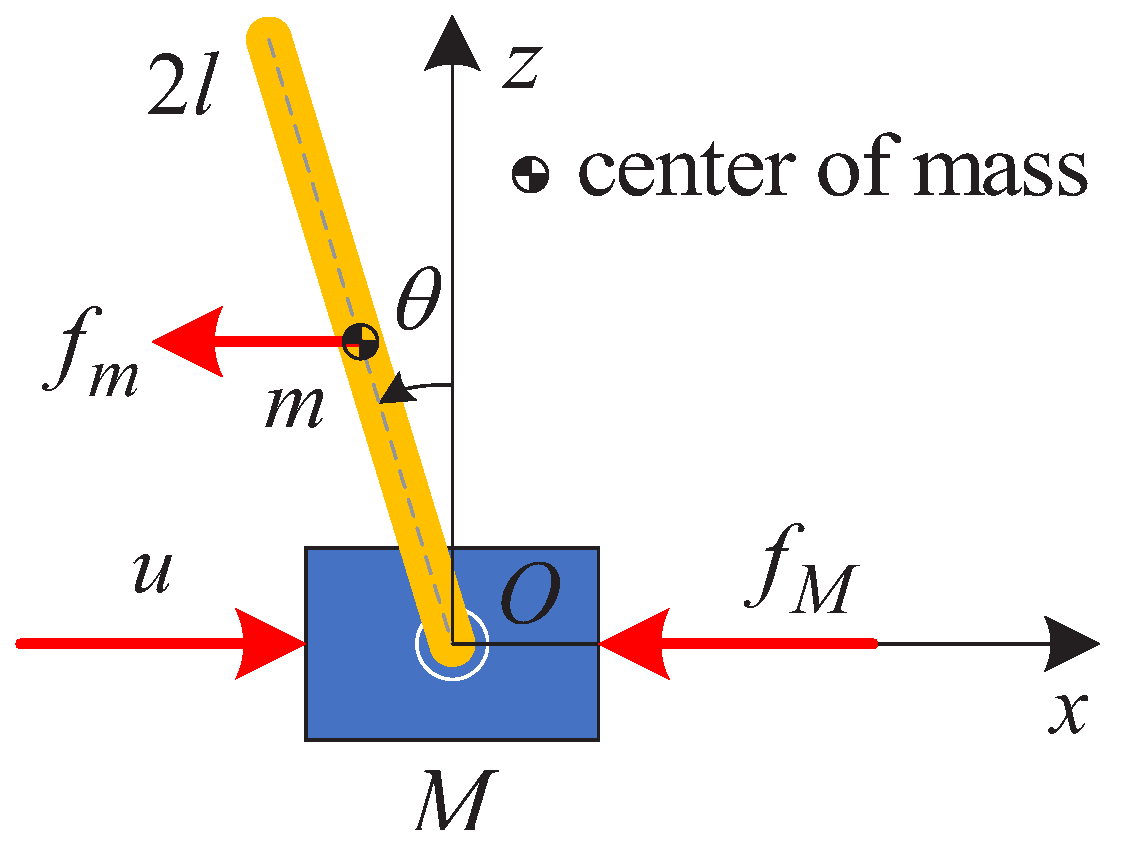

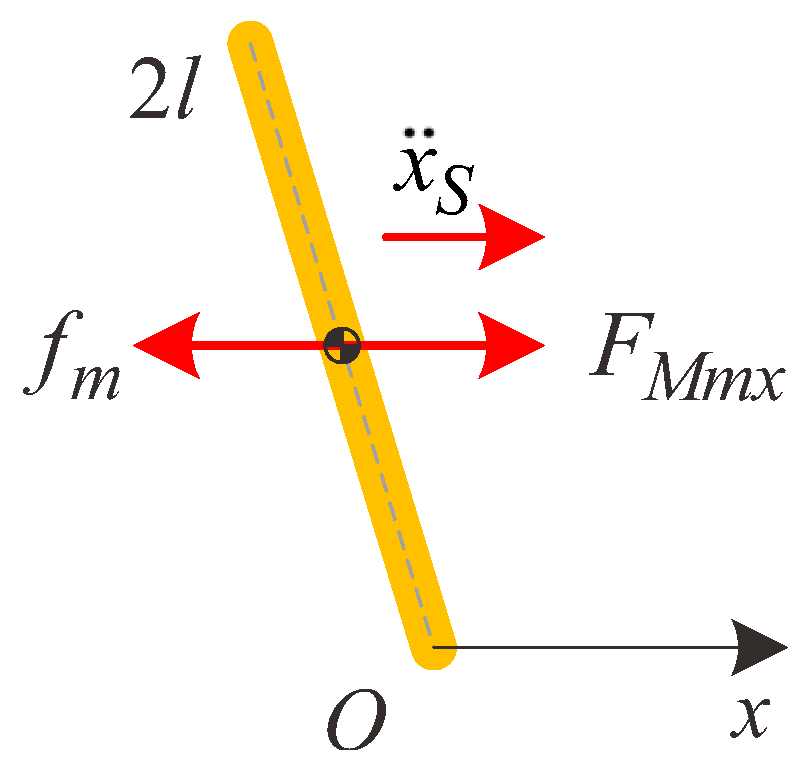
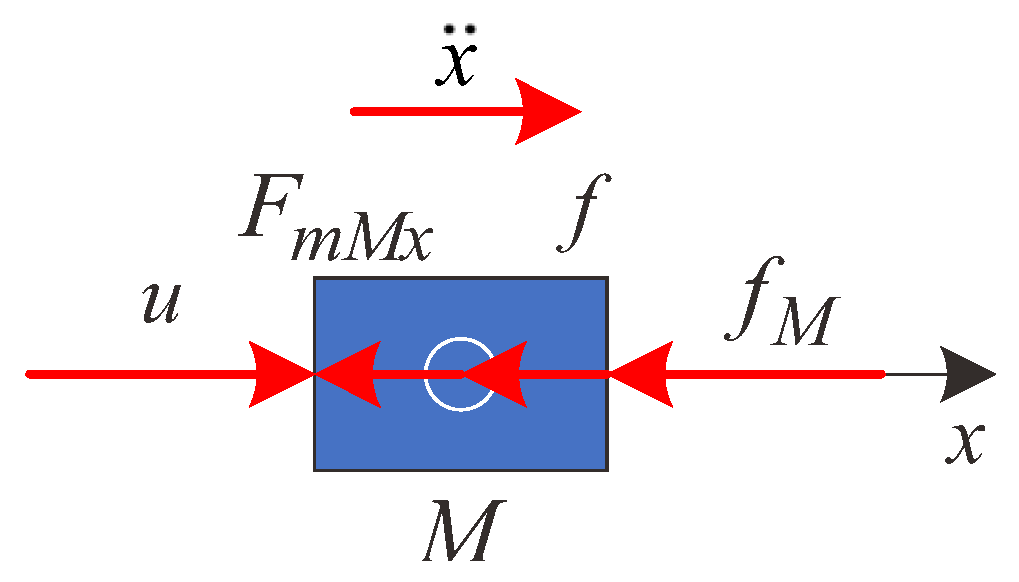
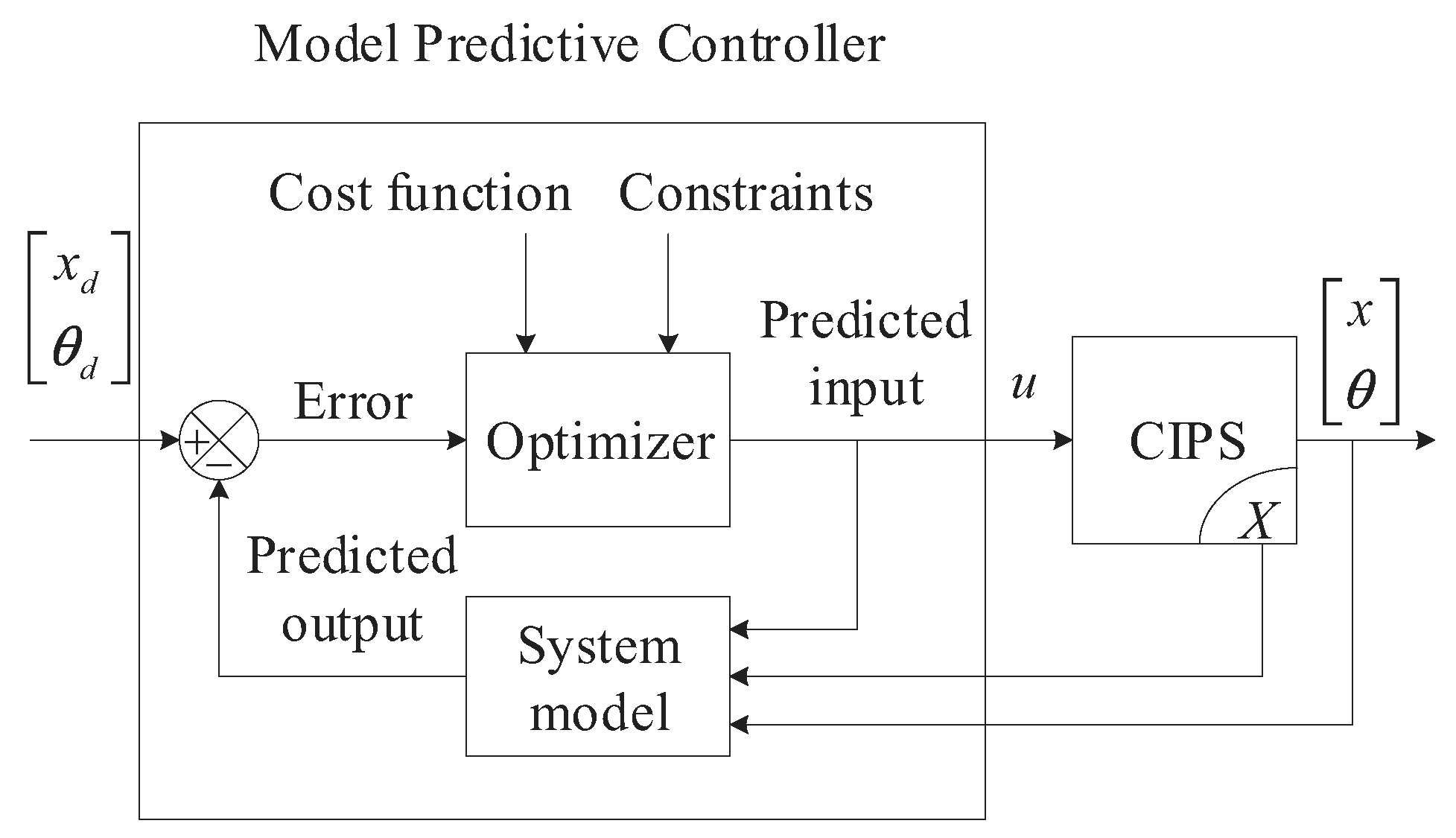
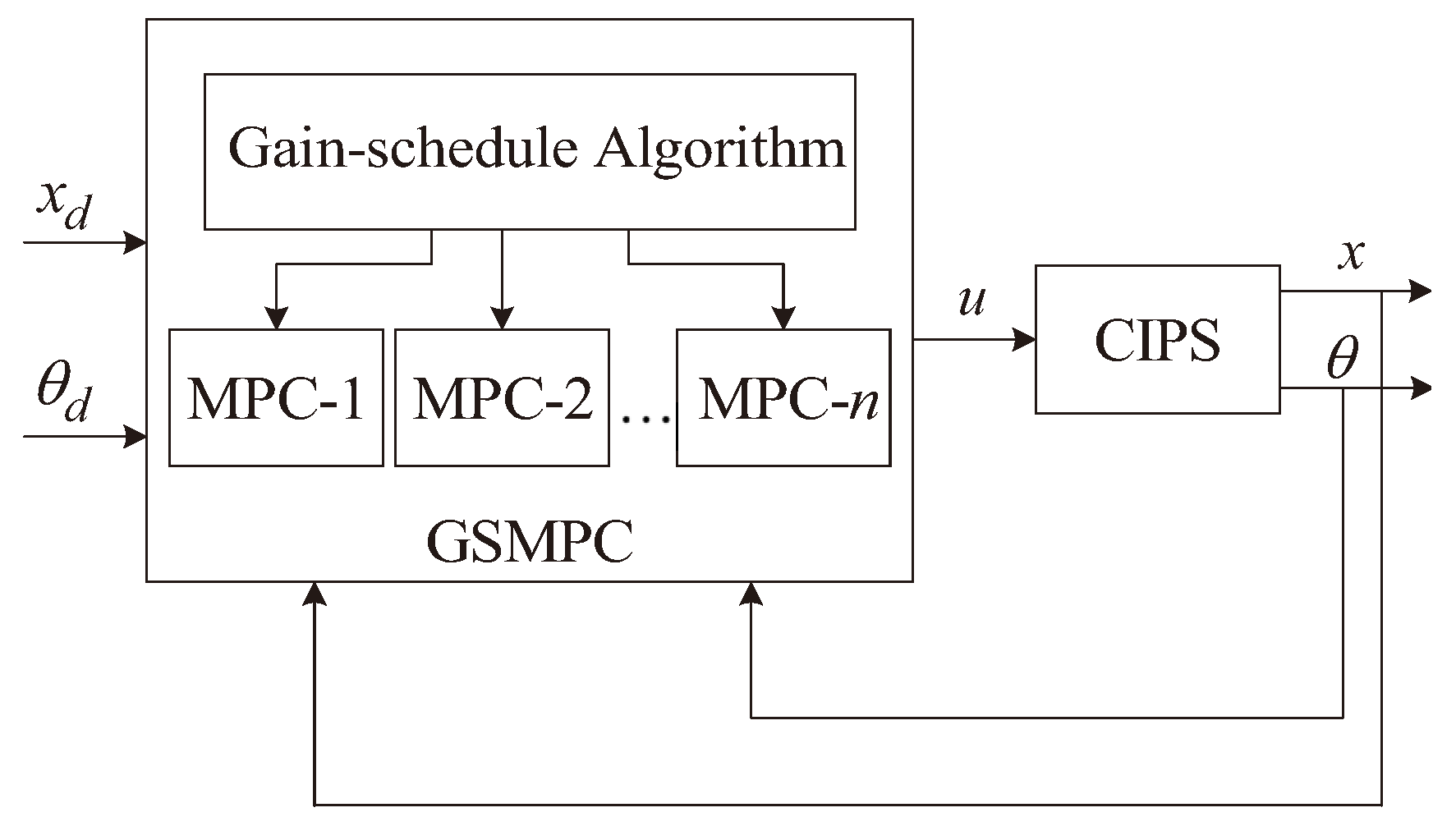
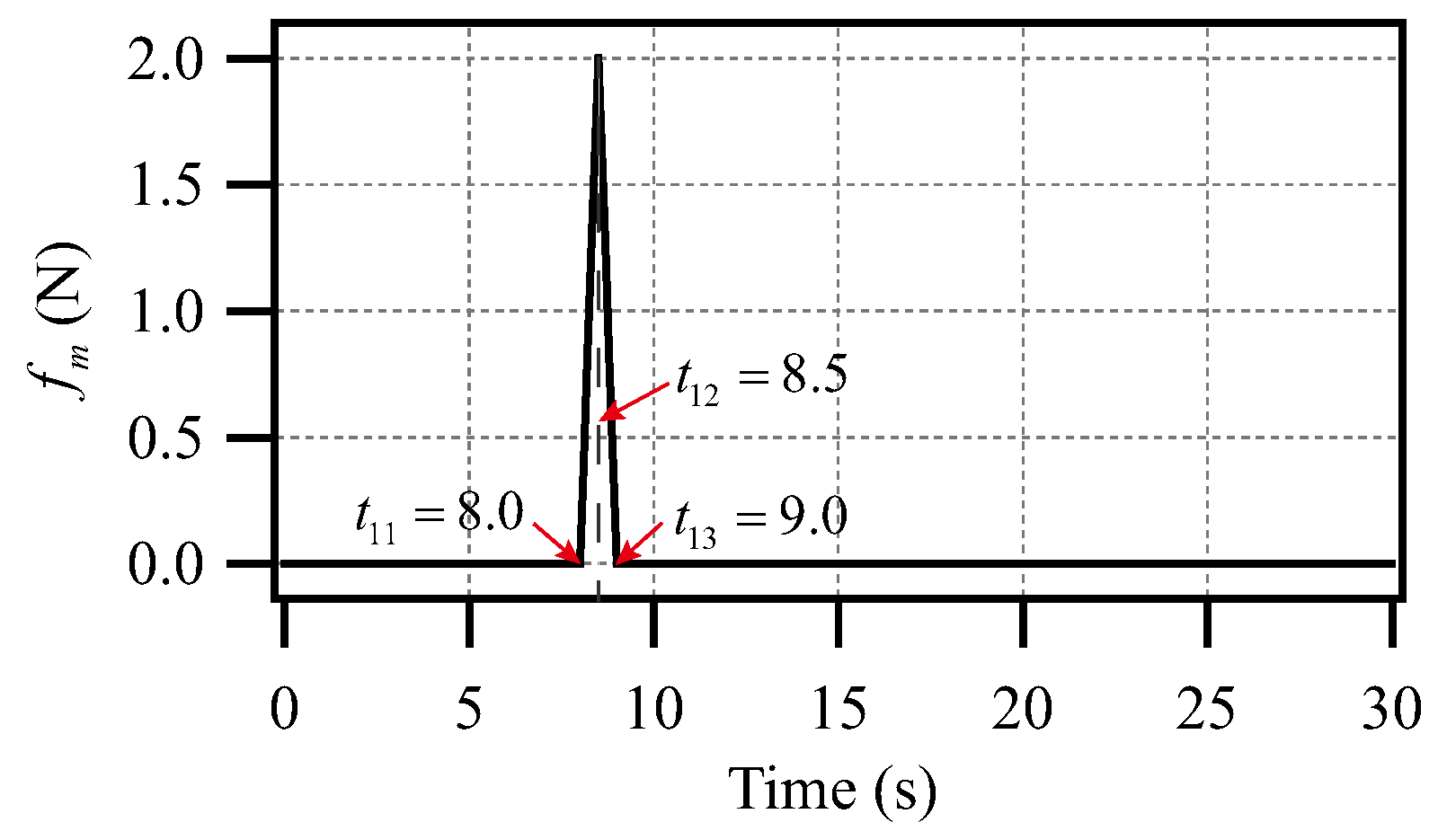
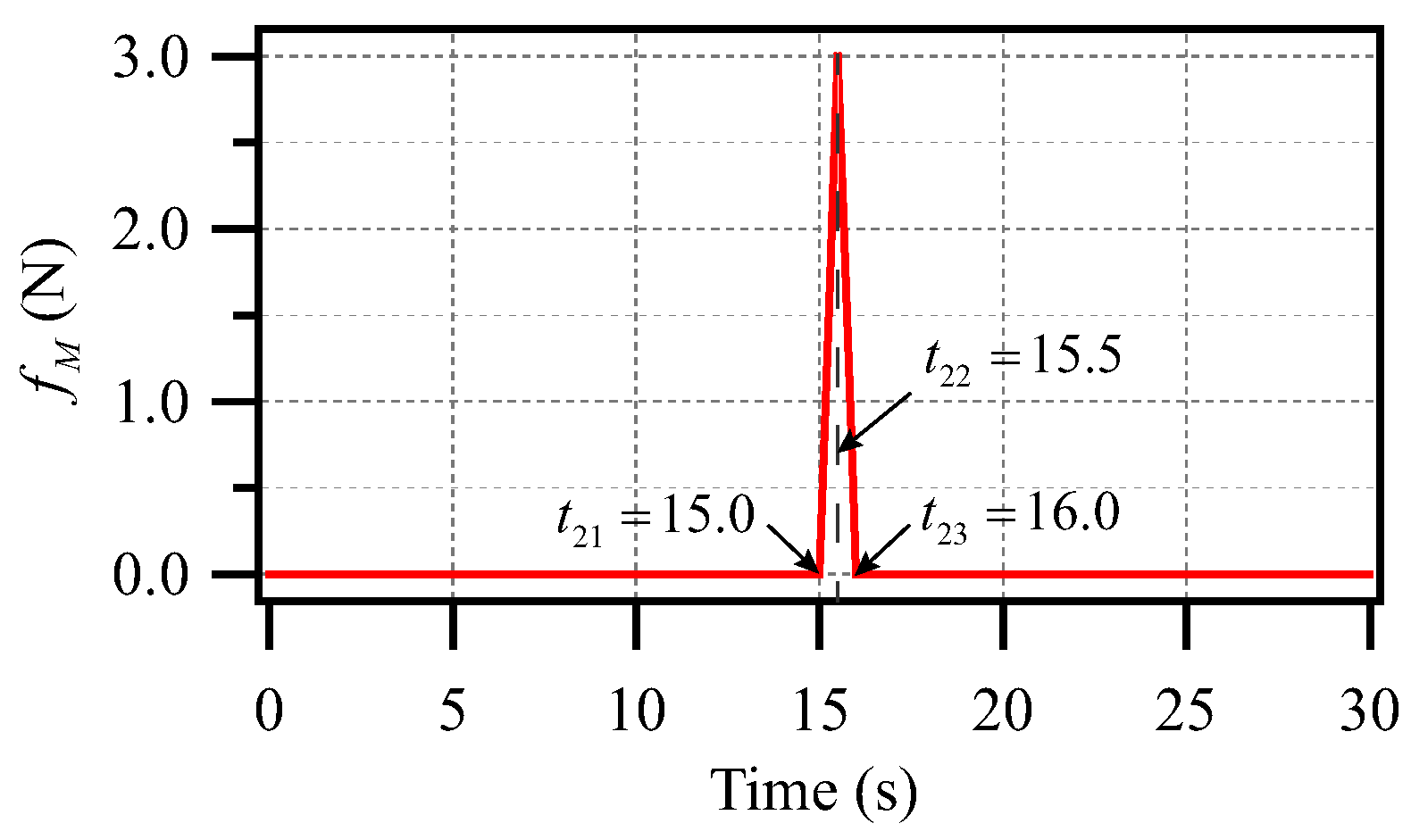
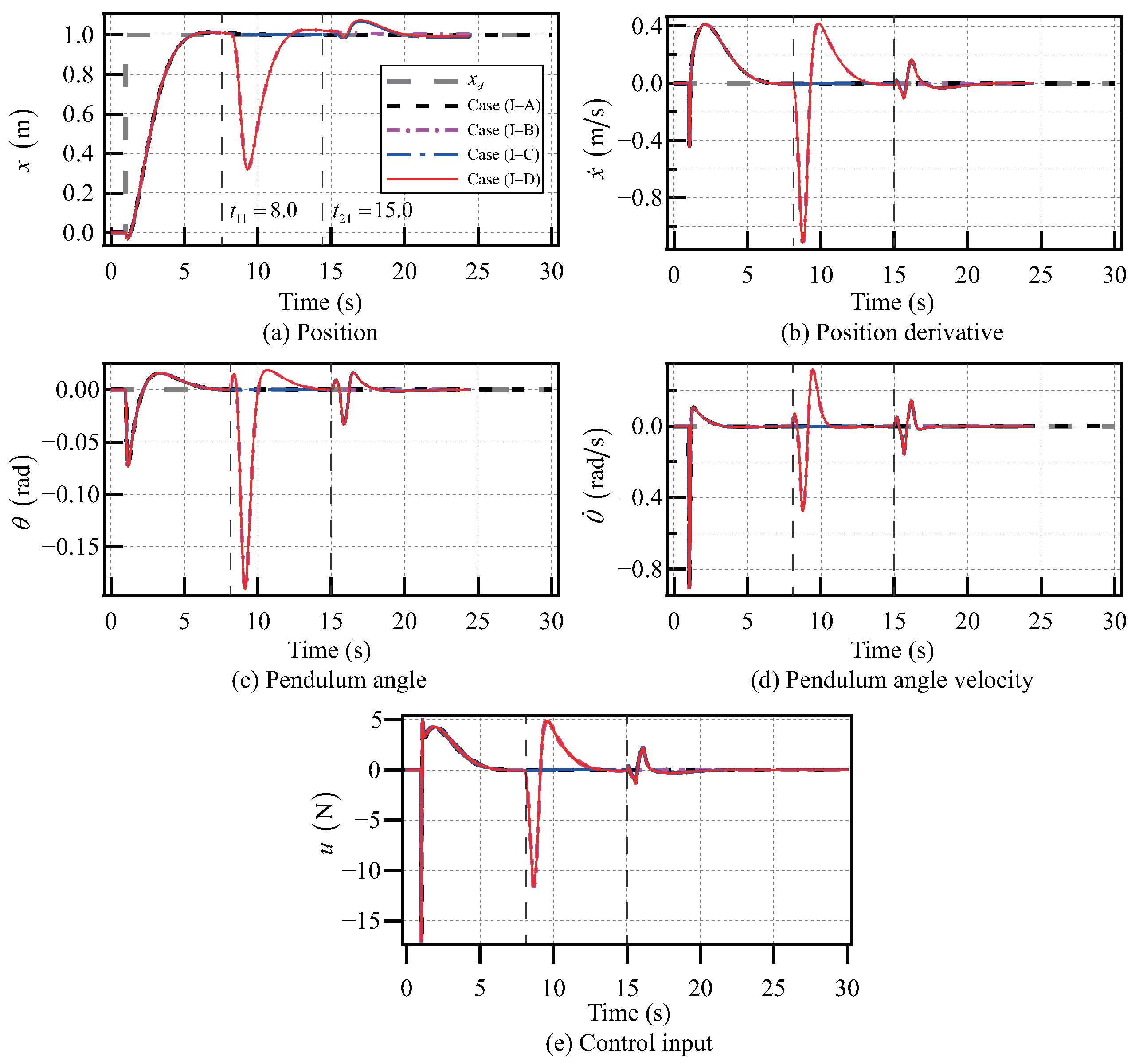
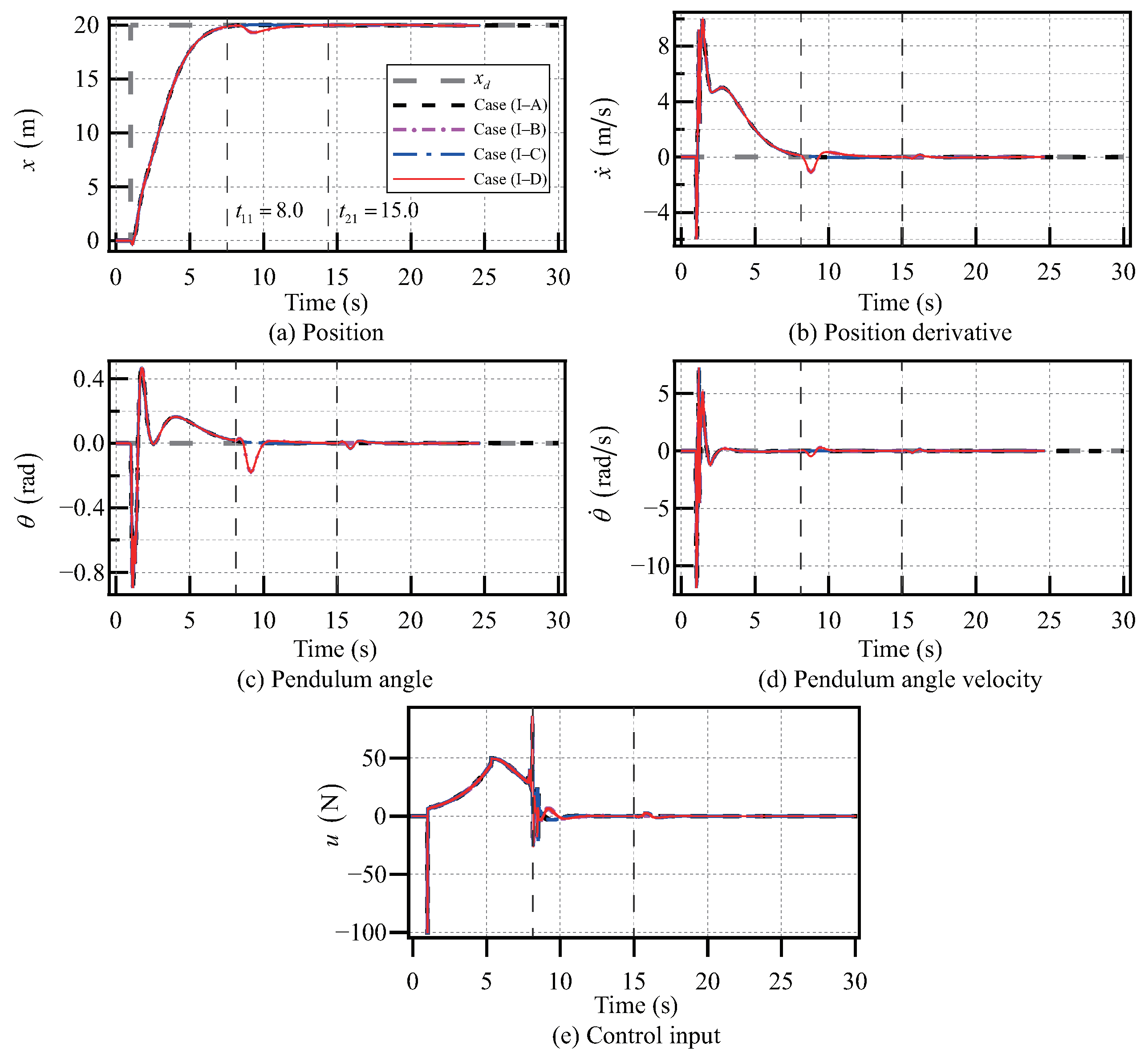
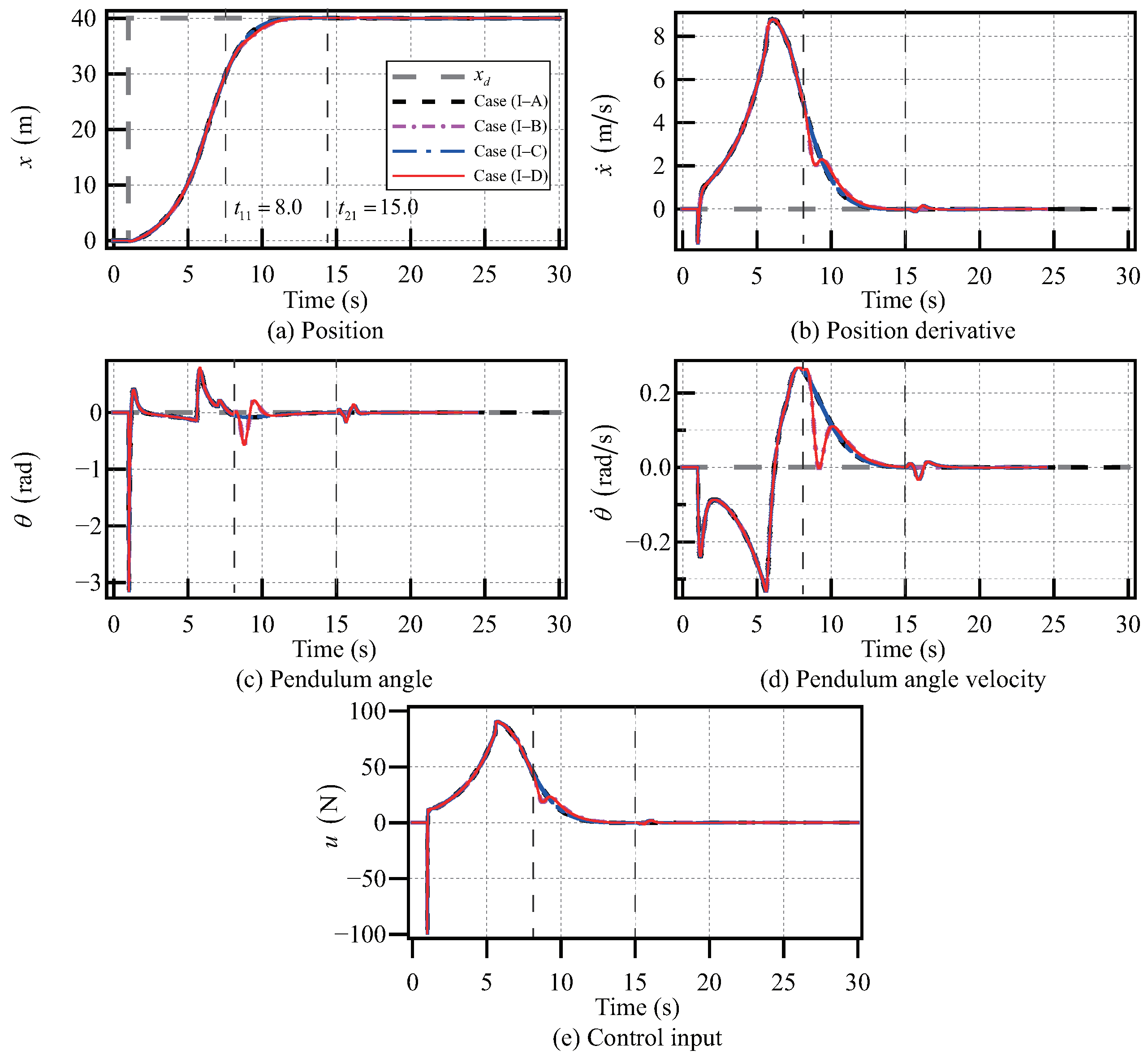
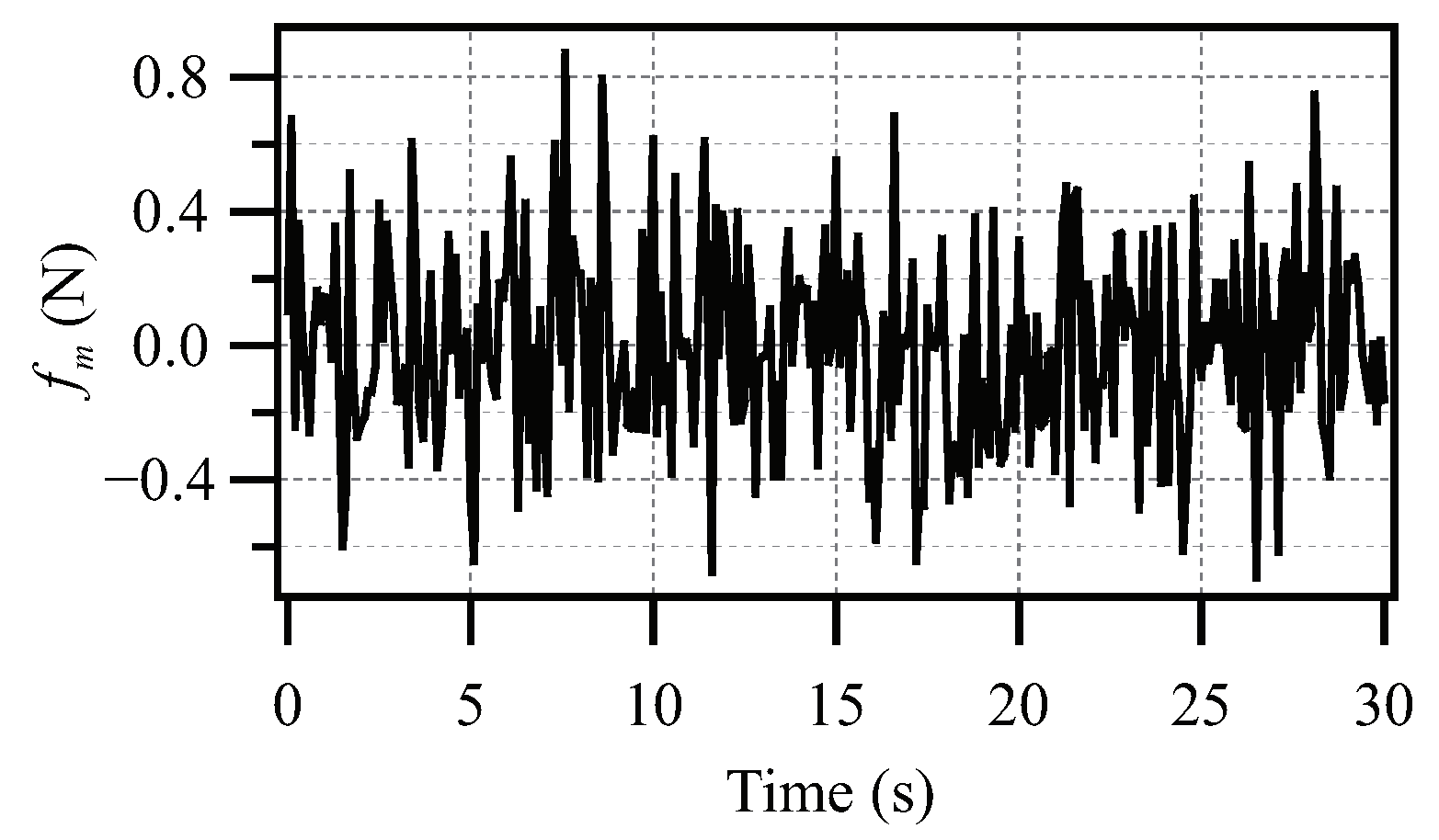
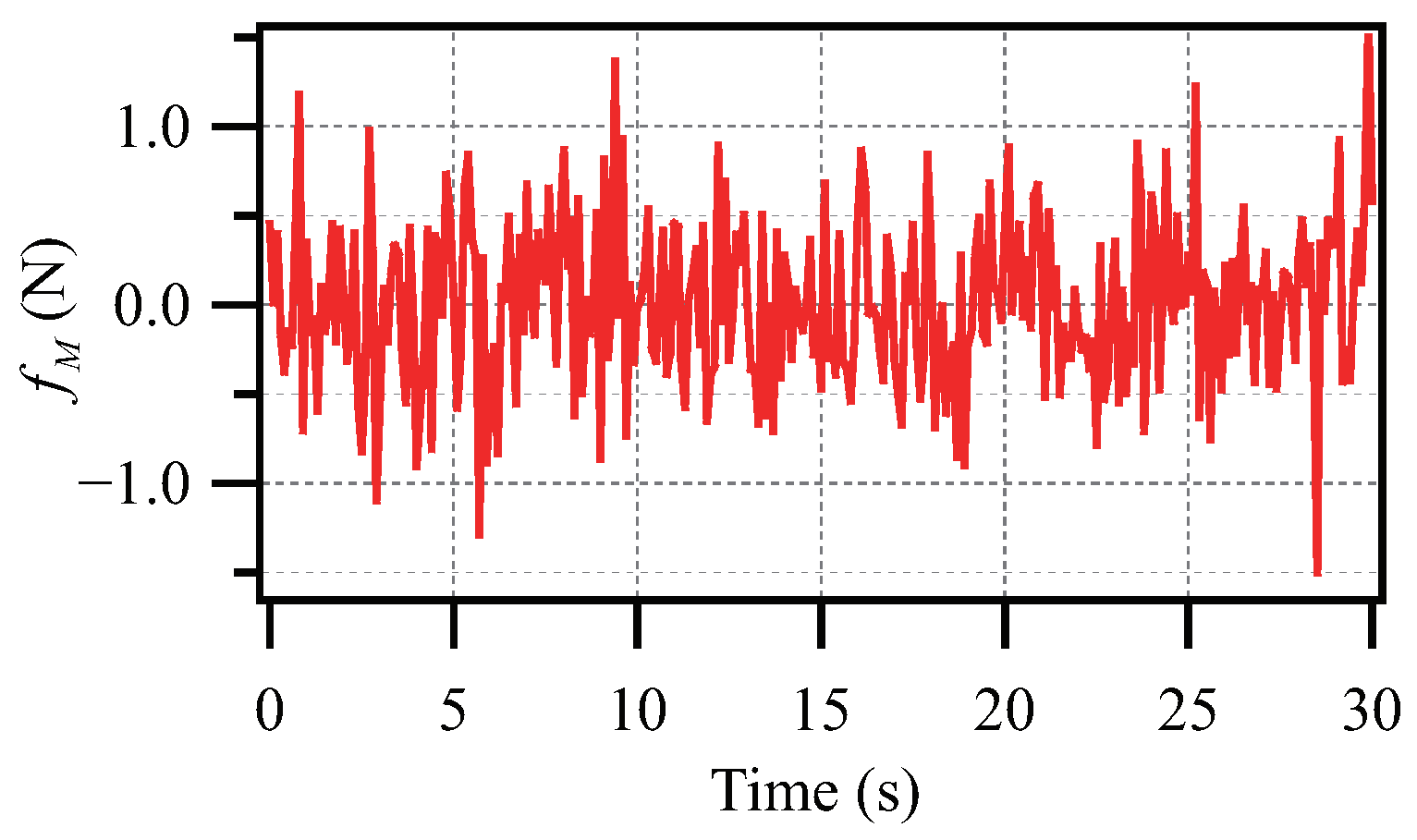

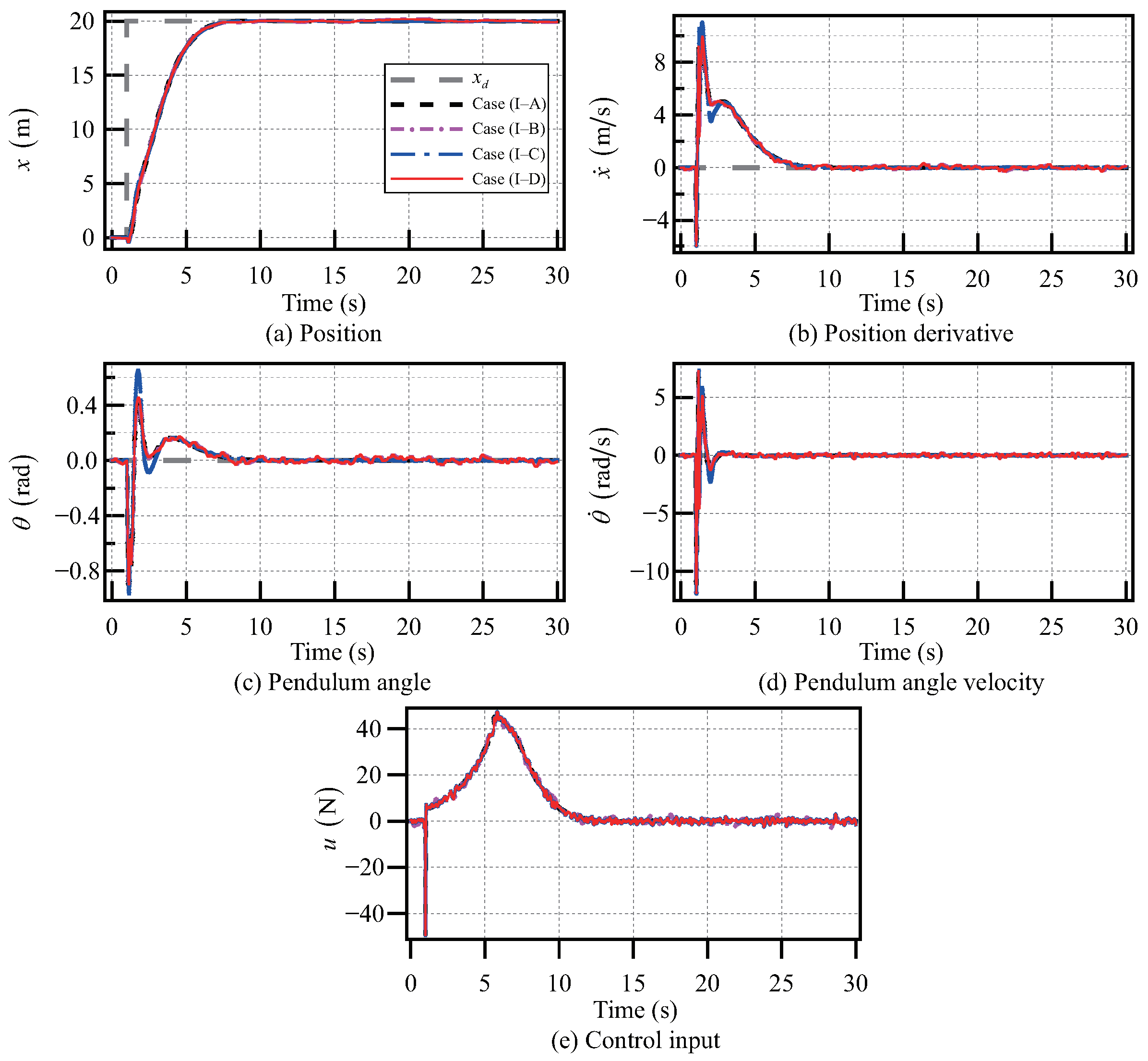

| M (kg) | m (kg) | l (m) | (kg/s) |
|---|---|---|---|
| 1.0 | 1.0 | 0.5 | 10 |
Disclaimer/Publisher’s Note: The statements, opinions and data contained in all publications are solely those of the individual author(s) and contributor(s) and not of MDPI and/or the editor(s). MDPI and/or the editor(s) disclaim responsibility for any injury to people or property resulting from any ideas, methods, instructions or products referred to in the content. |
© 2023 by the authors. Licensee MDPI, Basel, Switzerland. This article is an open access article distributed under the terms and conditions of the Creative Commons Attribution (CC BY) license (https://creativecommons.org/licenses/by/4.0/).
Share and Cite
He, J.; Li, Y.; Wei, Z.; Huang, Z. Gain-Scheduled Model Predictive Control for Cart–Inverted-Pendulum with Friction and Disturbances. Appl. Sci. 2023, 13, 13080. https://doi.org/10.3390/app132413080
He J, Li Y, Wei Z, Huang Z. Gain-Scheduled Model Predictive Control for Cart–Inverted-Pendulum with Friction and Disturbances. Applied Sciences. 2023; 13(24):13080. https://doi.org/10.3390/app132413080
Chicago/Turabian StyleHe, Jue, Yongbo Li, Ziang Wei, and Zixin Huang. 2023. "Gain-Scheduled Model Predictive Control for Cart–Inverted-Pendulum with Friction and Disturbances" Applied Sciences 13, no. 24: 13080. https://doi.org/10.3390/app132413080
APA StyleHe, J., Li, Y., Wei, Z., & Huang, Z. (2023). Gain-Scheduled Model Predictive Control for Cart–Inverted-Pendulum with Friction and Disturbances. Applied Sciences, 13(24), 13080. https://doi.org/10.3390/app132413080






